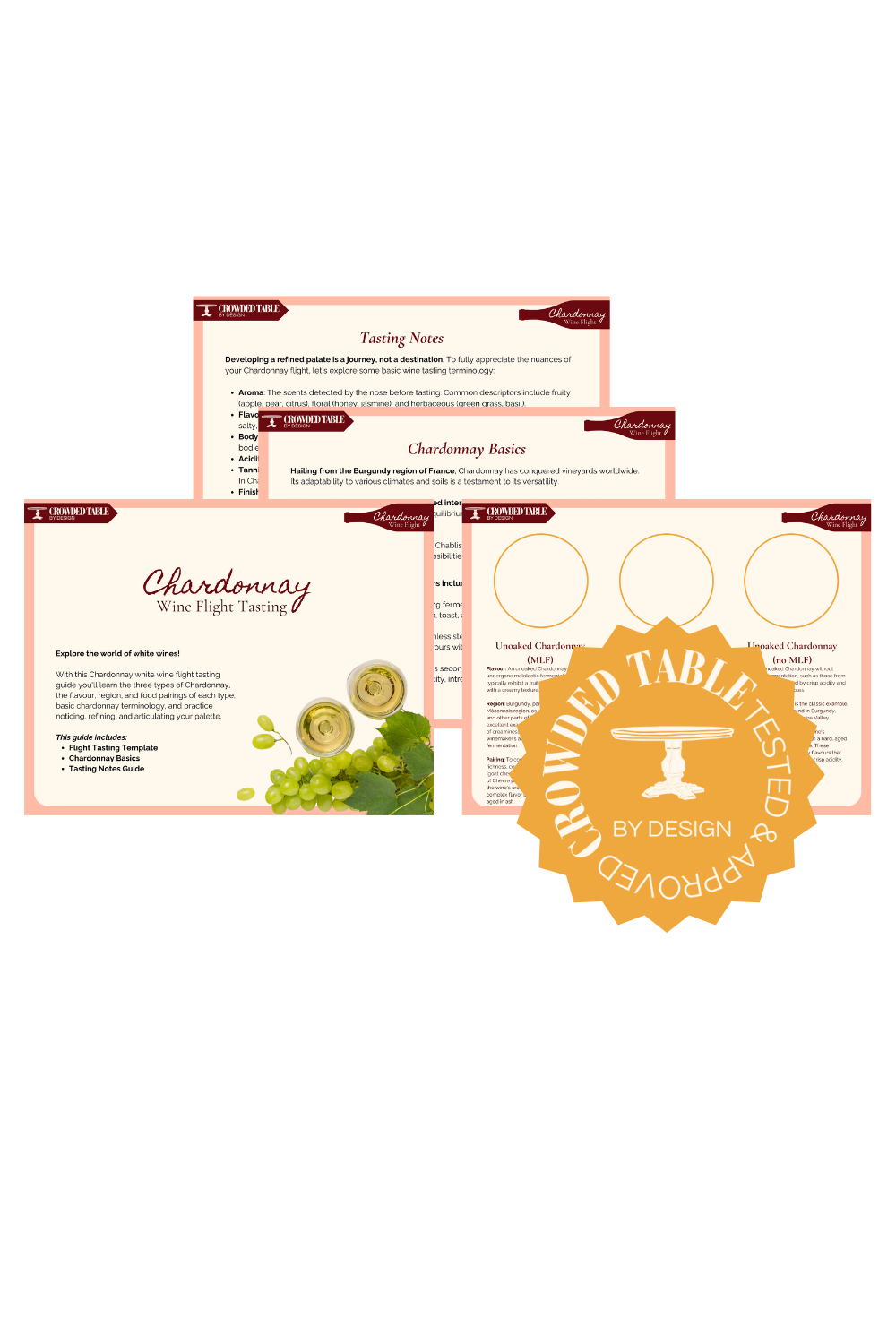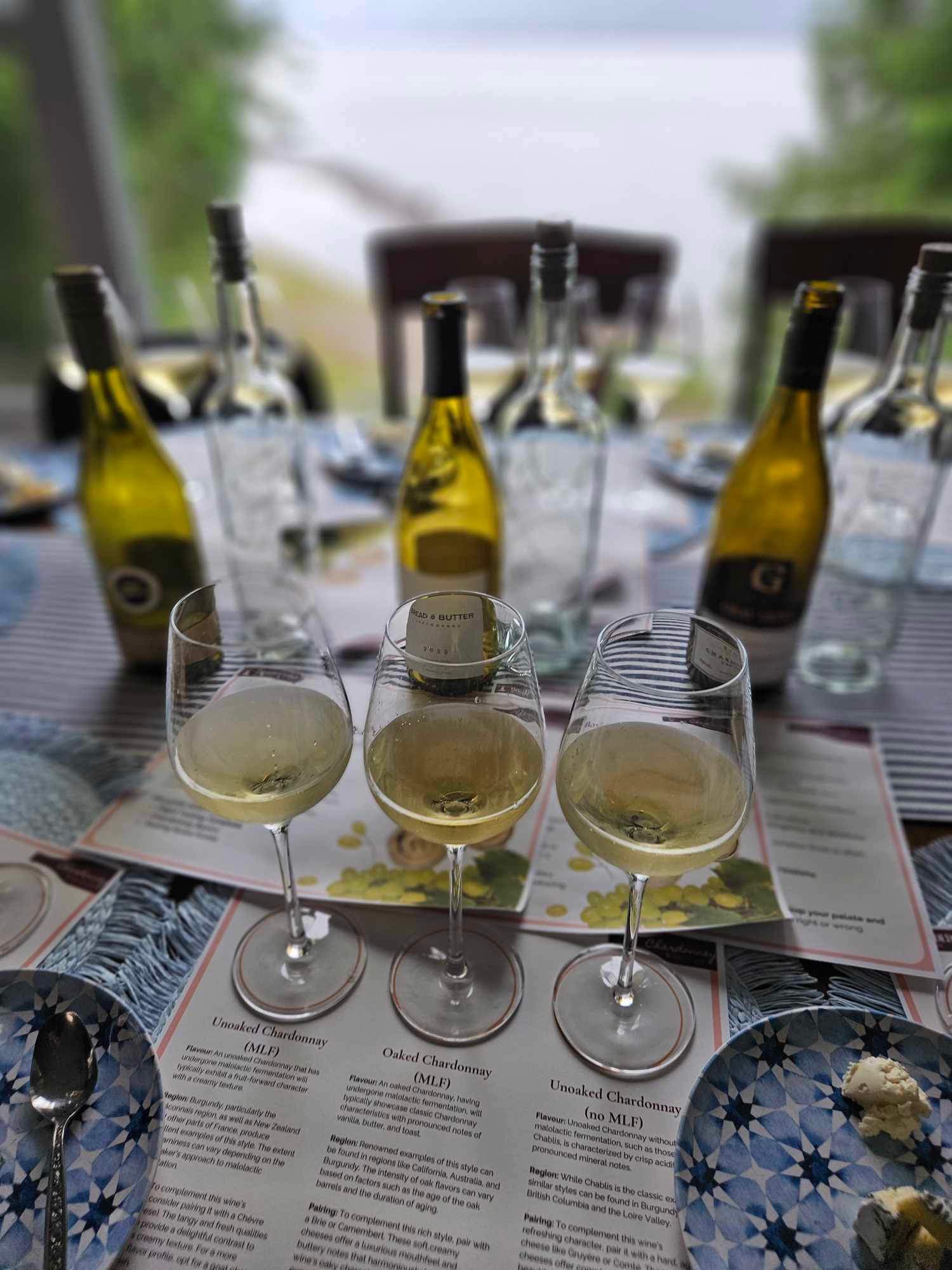Chardonnay Flight Tasting: A Gathering of Taste
Chardonnay: More Than Meets the Eye
Is there a wine as misunderstood as Chardonnay? Often relegated to the realm of simple, buttery indulgences, this versatile grape variety offers a world of complexity and nuance. From crisp and refreshing to rich and buttery, Chardonnay can be a chameleon, adapting to different terroirs and winemaking styles. It’s time to dispel the myths and discover the true potential of this extraordinary wine.
Chardonnay is more than just a white wine; it's a canvas for winemakers. With its ability to express a wide range of flavours and textures, it’s a perfect choice for a wine flight night. In this blog, we’ll guide you through hosting a Chardonnay extravaganza, pairing these exceptional wines with carefully selected cheeses for an unforgettable gathering.
Gather your crowd for an evening of discovery as you explore the fascinating world of Chardonnay. Let’s raise a glass to this remarkable grape and celebrate its diversity.
Chardonnay Basics
Hailing from the Burgundy region of France, Chardonnay has conquered vineyards worldwide.
Its adaptability to various climates and soils is a testament to its versatility. At its core, Chardonnay offers a balanced interplay of acidity, fruitiness, and often, the influence of oak aging. This delicate equilibrium is what makes it such a fascinating grape to explore.
From the crisp, mineral-driven styles of Chablis to the opulent, buttery expressions of California, Chardonnay presents a spectrum of possibilities. Key factors influencing these variations include:
Oaking: The use of oak barrels during fermentation and aging imparts flavours of vanilla, toast, and sometimes, smoky or buttery notes.
Unoaked: Wines aged solely in stainless steel or concrete tanks retain purer fruit flavours with a brighter acidity.
Malolactic Fermentation (MLF): This secondary fermentation softens the wine's acidity, introducing creamy and buttery undertones.
Why Chardonnay is Versatile
Chardonnay's chameleon-like nature is a winemaker's dream. By manipulating factors like grape maturity, fermentation techniques, and aging, winemakers can craft an astonishing array of flavours and styles. This versatility extends far beyond the oaked versus unoaked dichotomy. Consider the influence of:
Terroir: The unique combination of soil, climate, and topography imparts distinct characteristics to the grapes.
Clone selection: Different Chardonnay clones exhibit varying levels of acidity, fruit intensity, and susceptibility to oak.
Harvest timing: Grapes harvested earlier tend to produce crisper wines, while later harvests result in richer styles.
This diversity of production methods means that Chardonnay can complement a wide range of culinary experiences, from delicate seafood to rich poultry and even hearty vegetarian dishes. Its ability to adapt makes it a truly exciting wine to explore and enjoy.
Choosing Your Chardonnays
Selecting the perfect Chardonnays for your flight is an exciting adventure. To showcase the wine's versatility, aim for a trio that highlights different styles. Here's a breakdown:
Oaked Chardonnay with Malolactic Fermentation (MLF): This wine will exhibit classic Chardonnay characteristics with notes of vanilla, butter, and toast. Look for regions like California, Australia, or Burgundy for renowned examples. Consider factors like the age of the oak barrels and the length of aging to influence the intensity of oak flavours.
Unoaked Chardonnay with Malolactic Fermentation (MLF): This option will showcase fruit-forwardness with a creamy texture. Regions like Burgundy (especially the Mâconnais), New Zealand, and parts of France offer excellent examples. Pay attention to the winemaker's approach to MLF to determine the level of creaminess.
Unoaked Chardonnay without Malolactic Fermentation (or Chablis): This style emphasizes crisp acidity and mineral notes. Chablis is the quintessential example, but you can also explore other regions like Burgundy or the Loire Valley.
When selecting your Chardonnays, consider these factors:
Region: Different regions impart unique characteristics to the grapes.
Producer: Research winemakers known for their Chardonnay expertise.
Price point: Set a budget that allows you to explore a range of quality Chardonnays.
Availability: Ensure you can easily source the chosen wines.
Remember, the goal is to create a tasting experience that highlights the diversity of Chardonnay. Experiment with different producers and styles to discover your personal preferences.
Tasting Notes
Developing a refined palate is a journey, not a destination. To fully appreciate the nuances of your Chardonnay flight, let's explore some basic wine tasting terminology:
Aroma: The scents detected by the nose before tasting. Common descriptors include fruity (apple, pear, citrus),floral (honey, jasmine), and herbaceous (green grass, basil).
Flavour: The sensations experienced on the palate. Look for descriptors like sweet, sour, salty, bitter, umami, and the presence of fruit, oak, or mineral notes.
Body: The weight or fullness of the wine on the palate. Wines can be light-bodied, medium-bodied, or full-bodied.
Acidity: The tartness or freshness of the wine. It provides balance and structure.
Tannin: Primarily found in red wines, tannins contribute to a wine's astringency and structure. In Chardonnay,tannins can come from oak aging.
Finish: The lingering impression of the wine after swallowing. A long, complex finish is often desirable.
As you taste each Chardonnay, encourage yourself to articulate your impressions. What aromas and flavours do you detect? How does the wine feel on your palate? Comparing and contrasting the different Chardonnays will help you develop your palate and deepen your appreciation for this versatile grape. Remember, there are no right or wrong answers; your personal tasting experience is unique and valuable.
The Perfect Cheese Pairing
Cheese and Wine Harmony
The art of pairing cheese and wine is a delicate dance of flavours and textures.
At its core, the science lies in the interplay of acidity, fat, and salt. The acidity in wine can cut through the richness of cheese, while the fat in cheese can soften the tannins in wine. The goal is to create a harmonious balance that enhances the taste of both elements.
Consider the following when pairing cheese and wine:
Complementarity: Choose cheeses with flavours that complement the wine's characteristics. For example, a fruity Chardonnay pairs well with a cheese that has similar fruit notes.
Contrast: Sometimes, contrasting flavours can create an exciting experience. A slightly acidic cheese can balance the richness of an oaked Chardonnay.
Texture: The texture of the cheese should complement the mouthfeel of the wine. A creamy cheese pairs well with a full-bodied Chardonnay, while a crumbly cheese might work better with a lighter style.
Three Cheese Selections
To complement your Chardonnay flight, consider these cheese pairings:
Unoaked Chardonnay with Malolactic Fermentation: A Chèvre (goat cheese) is an excellent choice. Its tangy, fresh flavour contrasts beautifully with the creamy texture of the wine. For a more complex profile, consider a goat cheese aged in ash.
Oaked Chardonnay with Malolactic Fermentation: Pair with a Brie or Camembert. These soft, creamy cheeses offer a rich, buttery flavour that complements the oaky notes of the wine. For a more intense experience, try a triple-cream Brie.
Unoaked Chardonnay without Malolactic Fermentation (or Chablis): Opt for a hard, aged cheese like Gruyère or Comté. These cheeses offer nutty, complex flavours that stand up to the wine's crisp acidity.
Dairy-Free Alternatives
While cheese is a classic pairing, there are delicious alternatives for those who prefer to avoid dairy:
Charcuterie: Cured meats like prosciutto, salami, and chorizo offer a savoury complement to Chardonnay.
Nuts and Seeds: Almonds, walnuts, and pumpkin seeds provide texture and a nutty flavour.
Olives: A variety of olives, from green to Kalamata, offer briny and fruity notes.
Fruit: Grapes, apples, and pears can add sweetness and acidity to balance the wine.
Vegan Cheese: There are a growing number of plant-based cheese alternatives that can be enjoyed with wine.
Remember, these are just suggestions. The best way to discover your perfect pairings is to experiment and have fun!
Hosting Your Chardonnay Flight Night
Setting the Mood
Transform your space into a welcoming oasis for wine enthusiasts. Soft lighting, candles, and perhaps some floral arrangements can create a relaxed atmosphere. Encouraging guests to dress comfortably will help them feel at ease.
To add an interactive element, consider creating a wine and cheese quiz. This can be a fun way to test guests' knowledge and spark conversation. Alternatively, prepare a short presentation about Chardonnay or the different winemaking techniques.
Food and Beverage Pairing
While cheese is the star of the show, don't hesitate to offer additional food pairings to complement your Chardonnay flight. Consider the following:
Bread and crackers: Provide a variety of options to cleanse the palate between sips.
Charcuterie: A selection of cured meats can add complexity to the tasting experience.
Fresh fruit: Grapes, apples, and pears offer refreshing counterpoints to the wine.
Olives: Briny olives can enhance the flavours of the Chardonnay.
Serving your Chardonnay at the correct temperature is crucial. As a general rule, white wines should be served slightly chilled, around 8-10°C (46-50°F). Use appropriate glassware, such as Burgundy or white wine glasses, to allow the wine to breathe and release its aromas.
Behind the Scenes: A Stormy Chardonnay Flight
Our Chardonnay Flight experience took an unexpected turn when a sudden downpour forced us to host indoors. However, this turned out to be a blessing in disguise. By setting the table in front of the window facing the lake, we were able to enjoy the tranquil view, from the comfort of our cozy space.
Mother Nature may have had other plans for our lakeside toast, but it reminded us that the true magic of a gathering lies in the people, not the setting. The storm added a touch of drama and created a unique atmosphere that enhanced the experience.
For our Chardonnay flight, I selected the following wines:
Kim Crawford Chardonnay (New Zealand): A crisp, unoaked Chardonnay with MLF, offering bright fruit flavours and a refreshing acidity.
Bread and Butter Chardonnay (California): A rich, oaked Chardonnay with MLF, showcasing notes of vanilla,butter, and toast.
Grey Monk Chardonnay (British Columbia): A unoaked Chardonnay without MLF, emphasizing mineral notes and a crisp, refreshing finish.
Each wine offered a distinct experience, highlighting the versatility of Chardonnay. As we sipped and savoured, we shared stories, laughter, and a deep appreciation for the beauty of both the wine and the company.
Hosting a Chardonnay flight night is more than just a gathering; it's an opportunity to explore the versatility of this remarkable grape and deepen your appreciation for wine. By carefully selecting Chardonnays with varying styles and pairing them with thoughtfully chosen cheeses or other accompaniments, you create a sensory experience that engages your palate and stimulates conversation.
Intentional dining experiences like these foster connections and create lasting memories. Sharing the joy of discovery with friends as you navigate the world of Chardonnay is a truly rewarding experience.
So, gather your crowd and elevate your next gathering with a Chardonnay flight night. Whether you're a seasoned wine enthusiast or simply looking to expand your palate, this event is sure to be a hit.













